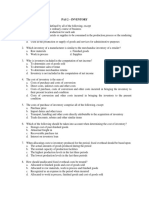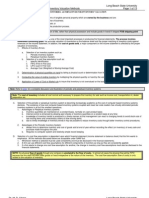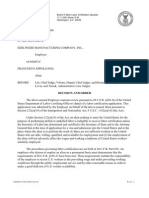Chapter 8 Quiz Answer Key
Chapter 8 Quiz Answer Key
Uploaded by
Sarah Marie LaytonCopyright:
Available Formats
Chapter 8 Quiz Answer Key
Chapter 8 Quiz Answer Key
Uploaded by
Sarah Marie LaytonOriginal Description:
Copyright
Available Formats
Share this document
Did you find this document useful?
Is this content inappropriate?
Copyright:
Available Formats
Chapter 8 Quiz Answer Key
Chapter 8 Quiz Answer Key
Uploaded by
Sarah Marie LaytonCopyright:
Available Formats
QUIZ CHAPTER 8 NAMES: _____SOLUTION________________________
1.When using a perpetual inventory system, a. no Purchases account is used. b. a Cost of Goods Sold account is used. c. two entries are required to record a sale. d. all of these. 2.Goods in transit which are shipped f.o.b. shipping point should be a. included in the inventory of the seller. b. included in the inventory of the buyer. c. included in the inventory of the shipping company. d. none of these. 3.Goods in transit which are shipped f.o.b. destination should be a. included in the inventory of the seller. b. included in the inventory of the buyer. c. included in the inventory of the shipping company. d. none of these. 4.Goods held on consignment are a. included in the inventory of the consignee. b. included in the inventory of the consignor until sold by the consignee. c. included in the inventory of the shipping company. d. none of these. 5.The inventory method chosen by a company will determine: a. how closely reported costs reflect the actual physical flow of inventory. b. the timing of reported income and income tax expense. c. how well costs are matched with associated revenues. d. all of the above. 6.Advantages of using the Dollar Value LIFO (DVL) method include: a. It simplifies the recordkeeping procedures compared to unit LIFO. b. It minimizes the probability of the liquidation of LIFO inventory layers. c. Can be used by firms that replace units sold with new units of the same kind. d. Both a and b. 7.The inventory system which provides more timely information but is more costly to implement is called the a. FIFO. b. LIFO. c. Periodic.
d. Perpetual. 8.The ratio that is designed to evaluate a companys effectiveness in managing its investment in inventory is the a. gross profit ratio. b. gross margin ratio. c. inventory turnover ratio. d. days in inventory ratio. 9.An inventory pricing procedure in which the oldest costs incurred rarely have an effect on the ending inventory valuation is a. FIFO. b. LIFO. c. base stock. d. weighted-average. 10.Which method of inventory pricing best approximates specific identification of the actual flow of costs and units in most manufacturing situations? a. Average cost b. First-in, first-out c. Last-in, first-out d. Base stock 11.Assuming no beginning inventory, what can be said about the trend of inventory prices if cost of goods sold computed when inventory is valued using the FIFO method exceeds cost of goods sold when inventory is valued using the LIFO method? a. Prices decreased. b. Prices remained unchanged. c. Prices increased. d. Price trend cannot be determined from information given. 12.In a period of rising prices, the inventory method which tends to give the highest reported net income is a. base stock. b. FIFO c. LIFO d. weighted-average. 13.In a period of rising prices, the inventory method which tends to give the highest reported inventory is a. FIFO. b. moving average. c. LIFO. d. weighted-average.
14.Managers closely monitor inventory levels in order to: a. ensure that the inventories needed to sustain operations are available. b. hold the cost of ordering and carrying inventories to the lowest possible level. c. both a and b. d. none of the above. 15.In a period of rising prices, the inventory method which tends to give the highest reported cost of goods sold is a. FIFO. b. average cost. c. LIFO. d. none of these.
You might also like
- In The Greater World - Francisco Candido XavierDocument155 pagesIn The Greater World - Francisco Candido XavierSun Wukong100% (2)
- Chapter 5 - Inventories: Revised EditionDocument7 pagesChapter 5 - Inventories: Revised EditionMelyssa Dawn Gullon0% (1)
- Finals PDFDocument6 pagesFinals PDFlapNo ratings yet
- Inventory 2 (Theories & Problems) With AnswersDocument11 pagesInventory 2 (Theories & Problems) With AnswersUzziehllah Ratuita100% (3)
- Inventories - TOADocument19 pagesInventories - TOAYen86% (7)
- Theories - Theory of School CounselingDocument2 pagesTheories - Theory of School Counselingapi-302472199No ratings yet
- 4 InventoriesDocument5 pages4 InventoriesandreamrieNo ratings yet
- Inventories and Investment in Associate TheoriesDocument15 pagesInventories and Investment in Associate TheoriesjonelynpvillanuevaNo ratings yet
- Activity-No.-9-Intermediate-Accounting-IDocument3 pagesActivity-No.-9-Intermediate-Accounting-IAlexandra RoqueNo ratings yet
- Pre QuizDocument3 pagesPre QuizJanella PatriziaNo ratings yet
- Chapter 26 - Inventory Cost Flow: Question 26-1Document11 pagesChapter 26 - Inventory Cost Flow: Question 26-1Cyrus IsanaNo ratings yet
- Chapter 8 Valuation of Inventories MCQ Unanswered Part3Document6 pagesChapter 8 Valuation of Inventories MCQ Unanswered Part3Ma Teresa B. CerezoNo ratings yet
- ACTG 431 QUIZ Week 2 Theory of Accounts Part 2 - INVENTORY VALUATION QUIZDocument4 pagesACTG 431 QUIZ Week 2 Theory of Accounts Part 2 - INVENTORY VALUATION QUIZMarilou Arcillas PanisalesNo ratings yet
- MTE CostDocument19 pagesMTE CostMarjhon TubillaNo ratings yet
- Quiz 1 Midterm InventoriesDocument6 pagesQuiz 1 Midterm InventoriesSophia TenorioNo ratings yet
- 09 - Inventories - TheoryDocument3 pages09 - Inventories - Theoryjaymark canayaNo ratings yet
- Quiz 4 - With Answers Part IIDocument6 pagesQuiz 4 - With Answers Part IIjanus lopezNo ratings yet
- Cfas Midterms q1Document3 pagesCfas Midterms q1Rommel Royce CadapanNo ratings yet
- 444Document4 pages444Carlo ParasNo ratings yet
- 555Document4 pages555Carlo ParasNo ratings yet
- Practice Set-Inventory (THEORY)Document5 pagesPractice Set-Inventory (THEORY)polxrixNo ratings yet
- Chapter 28 - Gross Profit and Retail Method: ANSWER 28-1Document12 pagesChapter 28 - Gross Profit and Retail Method: ANSWER 28-1Cyrus IsanaNo ratings yet
- Inventories Questions Edpalina-IsidroDocument2 pagesInventories Questions Edpalina-IsidroAndrea Florence Guy VidalNo ratings yet
- FinalsDocument6 pagesFinalslapNo ratings yet
- Answer-Key Acco-201 Intacc2 Mte 1say2324Document8 pagesAnswer-Key Acco-201 Intacc2 Mte 1say2324John cookNo ratings yet
- Act512 - Assignment Chapter - 06Document9 pagesAct512 - Assignment Chapter - 06Rafin MahmudNo ratings yet
- (Chp10-12) Pas 2 - Inventory, Inventory Valuation and Inventory EstimationDocument10 pages(Chp10-12) Pas 2 - Inventory, Inventory Valuation and Inventory Estimationbigbaek0% (3)
- 09 Chapter # 9 - InventoriesDocument29 pages09 Chapter # 9 - InventoriesNiña Yna Franchesca PantallaNo ratings yet
- Cost AccountingDocument1 pageCost Accounting夜晨曦No ratings yet
- 09 Inventories PDFDocument9 pages09 Inventories PDFKan Chích BôngNo ratings yet
- Fifo MethodDocument36 pagesFifo Methodabhisheksachan10No ratings yet
- Quiz-Inventory TheoryDocument4 pagesQuiz-Inventory TheoryCaila Nicole ReyesNo ratings yet
- ch09 PDFDocument40 pagesch09 PDFerylpaez100% (2)
- Assignment InventoriesDocument6 pagesAssignment InventorieshwhwhwhjiiiNo ratings yet
- FA!%Document2 pagesFA!%KirosTeklehaimanotNo ratings yet
- INTACC DQsDocument9 pagesINTACC DQsMa. Alessandra BautistaNo ratings yet
- Intermediate Accounting 1 - Quiz On InventoriesDocument8 pagesIntermediate Accounting 1 - Quiz On InventoriesGabriela Marie F. PalatulanNo ratings yet
- Review Handouts and Materials: Semester First Semester School Year 2019-2020 Subject Handout # TopicDocument34 pagesReview Handouts and Materials: Semester First Semester School Year 2019-2020 Subject Handout # TopicWilson TanNo ratings yet
- Quiz On Inventory - TheoriesDocument4 pagesQuiz On Inventory - TheoriesEms TeopeNo ratings yet
- Practice Quiz 07 - ACTG240 - Q2202122Document11 pagesPractice Quiz 07 - ACTG240 - Q2202122Đinh Ngọc Minh ChâuNo ratings yet
- PAS 2 - Inventories - QuizDocument4 pagesPAS 2 - Inventories - QuizQueenie Mae San JuanNo ratings yet
- TBCH 08Document54 pagesTBCH 08Tornike Jashi100% (1)
- Managerial Economics QuestionnairesDocument26 pagesManagerial Economics QuestionnairesClyde SaladagaNo ratings yet
- Inventories Valuation ConceptDocument13 pagesInventories Valuation ConceptSumit SahuNo ratings yet
- Valuation of Inventories: A Cost-Basis Approach: Chapter Learning ObjectivesDocument38 pagesValuation of Inventories: A Cost-Basis Approach: Chapter Learning ObjectivesmicahventuresNo ratings yet
- 1 What Principle or Assumption Results in The Use ofDocument1 page1 What Principle or Assumption Results in The Use ofhassan taimourNo ratings yet
- Quiz 4 - With AnswersDocument6 pagesQuiz 4 - With Answersjanus lopezNo ratings yet
- Quiz 3 - Intacc 2Document8 pagesQuiz 3 - Intacc 2Usagi TsukkiNo ratings yet
- Pas 2 InventoryDocument3 pagesPas 2 InventoryHardly Dare GonzalesNo ratings yet
- Quizz Chapter 6Document3 pagesQuizz Chapter 6Phùng Mỹ HạnhNo ratings yet
- RetailDocument3 pagesRetailcaryljoycemaceda3No ratings yet
- Absorption and Variable CostingDocument1 pageAbsorption and Variable CostingAzaleaNo ratings yet
- PAS 02 InventoriesDocument3 pagesPAS 02 InventoriesRia GayleNo ratings yet
- Chapter 5 Inventory Management Answer Key I. True or False Statements Black - TrueDocument14 pagesChapter 5 Inventory Management Answer Key I. True or False Statements Black - TruekNo ratings yet
- Theories InvetoriesDocument44 pagesTheories InvetoriesllllNo ratings yet
- Valuation of Inventories.a Cost Basis ApproachDocument36 pagesValuation of Inventories.a Cost Basis ApproachMarvin Agustin De CastroNo ratings yet
- Valuation of InventoriesDocument7 pagesValuation of InventoriesBarbie BleuNo ratings yet
- Ias 2 Test Bank PDFDocument11 pagesIas 2 Test Bank PDFAB Cloyd100% (1)
- Finance for Non-Financiers 2: Professional FinancesFrom EverandFinance for Non-Financiers 2: Professional FinancesNo ratings yet
- Inventory Accounting: A Comprehensive GuideFrom EverandInventory Accounting: A Comprehensive GuideRating: 5 out of 5 stars5/5 (1)
- Beyond Earnings: Applying the HOLT CFROI and Economic Profit FrameworkFrom EverandBeyond Earnings: Applying the HOLT CFROI and Economic Profit FrameworkNo ratings yet
- Effects of Parenting Styles On Young Childrens SoDocument4 pagesEffects of Parenting Styles On Young Childrens SochechichichuNo ratings yet
- School Profile 2020 2021 20 11 2020new 3Document5 pagesSchool Profile 2020 2021 20 11 2020new 3Phuong AnhNo ratings yet
- Comprehensive Problem Standard Costing PDFDocument2 pagesComprehensive Problem Standard Costing PDFMallet S. GacadNo ratings yet
- Difference Between Sub Agent and Substitute Agent - Aviral PathakDocument10 pagesDifference Between Sub Agent and Substitute Agent - Aviral PathakAviral PathakNo ratings yet
- Act 3 The CrucibleDocument2 pagesAct 3 The CrucibleDieu AnhNo ratings yet
- Practical Research IDocument18 pagesPractical Research Isaturninomyra398100% (1)
- X-X-X-X-X-X-XW-X-X-X-X-X) : Nbcdo Memorandum)Document2 pagesX-X-X-X-X-X-XW-X-X-X-X-X) : Nbcdo Memorandum)N.a. M. Tandayag100% (1)
- PEPT Online Registration Form - XLSX - Registration FormDocument1 pagePEPT Online Registration Form - XLSX - Registration FormDerick DalisayNo ratings yet
- EMILE DURKHEIM THEORIES FinalDocument18 pagesEMILE DURKHEIM THEORIES Finalfatima asadNo ratings yet
- ETHIOPIAN NATIONAL ENERGY POLICY Full 2013Document54 pagesETHIOPIAN NATIONAL ENERGY POLICY Full 2013EsheFikirNo ratings yet
- Leadership Development BrochureDocument23 pagesLeadership Development BrochureDiego FigueredoNo ratings yet
- Gorkhali Te Obc Status Pek Chungchangah Cyma Khauh: ThezozamtimesDocument1 pageGorkhali Te Obc Status Pek Chungchangah Cyma Khauh: ThezozamtimeshlaldinmawiaNo ratings yet
- House RulesDocument2 pagesHouse RulesXavvv Savellano100% (1)
- Mma Yakoma EntutuDocument2 pagesMma Yakoma EntutuEnock BoakyeNo ratings yet
- Understanding The CommunityDocument18 pagesUnderstanding The CommunityElai TolentinoNo ratings yet
- D 71 C 69 B 1Document38 pagesD 71 C 69 B 1vincentzhu1001No ratings yet
- Terminal Attack Dive: Orbiter 1K Loitering Munition UASDocument2 pagesTerminal Attack Dive: Orbiter 1K Loitering Munition UASYiannis CamNo ratings yet
- The Lotus Sutra Chapter 7Document20 pagesThe Lotus Sutra Chapter 7Pushpinder Singh SandhuNo ratings yet
- BCM-101 Unit-6Document13 pagesBCM-101 Unit-6ManmithNo ratings yet
- Department of Labor: 1987 00562ADocument5 pagesDepartment of Labor: 1987 00562AUSA_DepartmentOfLaborNo ratings yet
- Store File PDF ActionDocument9 pagesStore File PDF ActionFatchukoNo ratings yet
- ECFMG On-Line Application 1Document1 pageECFMG On-Line Application 1PIU ISDBNo ratings yet
- Vikings and European Explorers Read OnlyDocument2 pagesVikings and European Explorers Read Onlyapi-554375952No ratings yet
- Villa Prime Rose Beed2a Contextualization ProcessDocument2 pagesVilla Prime Rose Beed2a Contextualization ProcessRustom Oyo-aNo ratings yet
- Affix Recent Passport Size Photo: Application FormDocument1 pageAffix Recent Passport Size Photo: Application FormVipin ChandelNo ratings yet
- 5121 Present SimpleDocument2 pages5121 Present SimpleAlina Elena GheorgheNo ratings yet
- Social Aspects of Medico-Legal CasesDocument27 pagesSocial Aspects of Medico-Legal Casesdipanjan bhatacharjeeNo ratings yet
- Digest - Federal Pheonix Assurance v. Fortune Sea CarrierDocument1 pageDigest - Federal Pheonix Assurance v. Fortune Sea CarrierJolynnah DiñoNo ratings yet

























































































